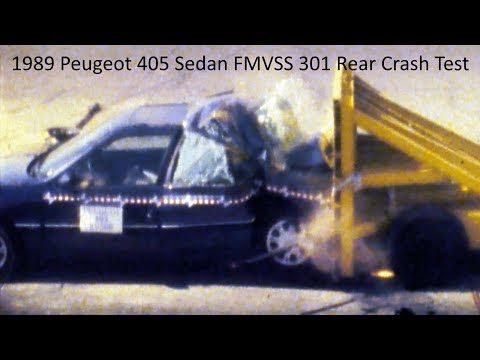Peugeot of the 1980s: Behind The Times on Safety

Note: this post concerns USA-market vehicles Peugeot made in 1991 and earlier, before they pulled out of the market, and does not reflect on Peugeots made after this date.
In America, you won’t find French cars for sale. France is the 11th largest manufacturer of cars, which is quite a high position for a nation which completely eschews the American market. They’re led by the French “Big Three” – Peugeot, Renault, and Citroen. All three of these companies once sold cars in America, but they’ve all long since slinked away from the market.
Citroen was the first to go in 1974, when its trademark height-adjustable suspension failed new bumper height regulations. Renault went away in 1987 amid the collapse of its American partner AMC. Peugeot was the last to go, remaining on sale until 1991.
Many have pinned Peugeot’s departure on their cars being “too quirky” for the American market, and while that may be true, they had been able to survive in the states since 1958. Peugeot sales peaked in the USA in 1984, with 20,007 cars sold that year.
A group called Motor Voters launched a boycott of Peugeot on August 22, 1988, citing the company’s “appallingly poor” safety record and lack of plans to introduce airbags. With sales already sagging – just 9,422 Peugeots were sold in 1987 – this seemed to be the final nail in the coffin, with only 4,261 sold in 1990, their last full year before announcing their closure.
Peugeot seemed to dodge a public relations bullet in 1980 when results for their 504 sedan came out; while its performance was by far the worst of any vehicle tested, the results were not nearly as widely covered in contemporary news sources as the results on other vehicles, perhaps because of Peugeot’s low sales volume.
But in the late 1980s, many more eyes were on Peugeot as its 505 model flunked three NHTSA crash tests in a row in each year from 1987-1989. While the 505’s performance was not as bad as the 504’s – which would be almost certainly fatal for even the strongest driver – car safety in general was held to a much higher priority among the general public by the late 1980s than it had been a decade earlier. At a time when the average risk of severe injury to occupants was 35% for drivers and 25% for front passengers in the NHTSA 35-mph front test, averaged together, the 505 averaged 85% for its driver and 78% for its passenger.
This is far worse than even the average 1979 vehicle, which had a risk of around 45% for both occupants.
It wasn’t just the 504 and 505 that were unsafe, either. Peugeot’s 405 model – introduced as a 1988 model, and tested as an ’89 – flunked a rear impact crash test at just 30 mph, with 62 ounces of fuel leaking – far exceeding the 5-ounce maximum, and plenty to start a fire. Consider that the vast majority of vehicles tested even in 1979 did far better than this Peugeot, with the exception of small hatchbacks with no rear crumple zone. While the 405 was never tested for frontal impact safety by NHTSA, it’s likely that it would have also done poorly.






